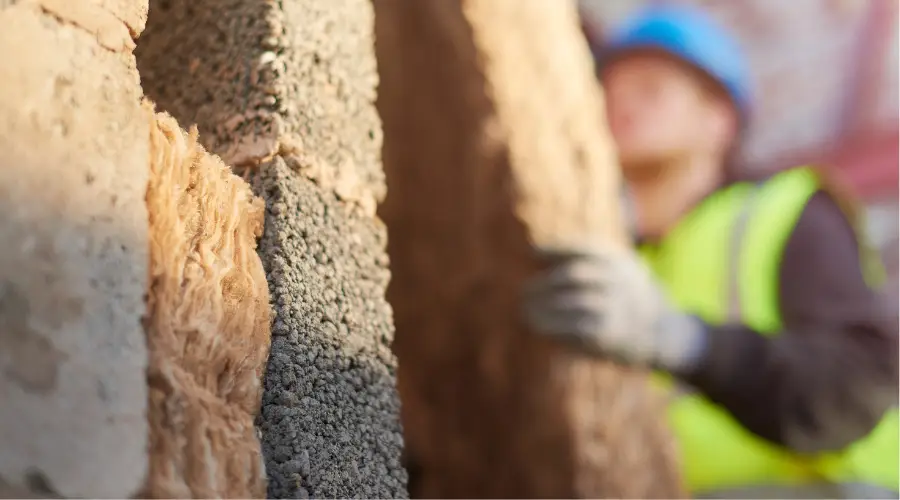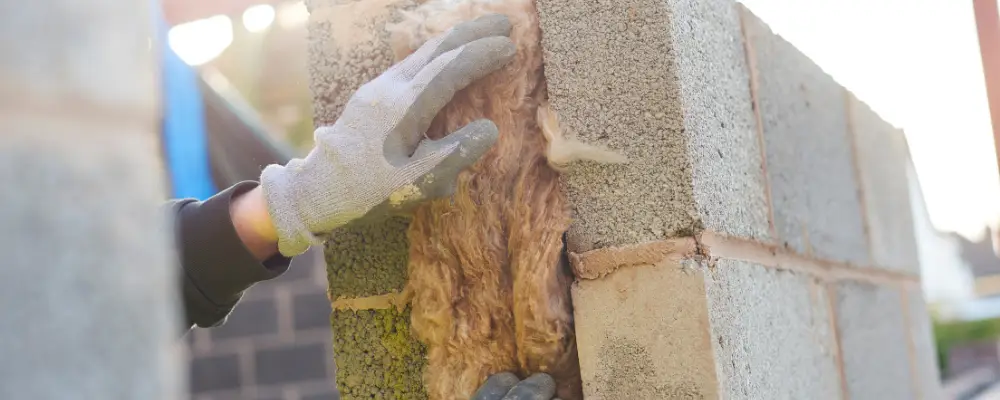Cavity wall insulation is one of the main factors that lead to energy-saving in a house, particularly ones with cavity walls. Here, the wall system is made up of two walls that have been separated and have a space, or a cavity, between them. This space, over time, can lead to considerable heat leakage, thus causing energy bills to skyrocket and the indoor comfort levels to drop. To limit the heat flow through the walls, insulation in the cavity wall is used. Energy efficiency aside, cavity wall insulation also takes on an important role in tackling a property’s carbon emissions and hence, this is a feature that environmentally conscious homeowners should invest in. This guide unravels different materials for cavity wall insulation, the benefits, installation methods and key factors you should consider to be able to make the right decision for your home’s insulation.
What is Cavity Wall Insulation?
Insulation for cavity walls is the process of placing an insulating material in the void between the different layers of the external walls of a building to stop heat from passing through them. The void is a separation between two brick or masonry walls. Adding insulation in this void is an energy-efficient measure, especially in extremely cold climates. By stopping or minimising the heat leakage through outer walls, its installation yields a very large saving of utility bills and ensures indoor thermal comfort across different seasons.
How Does Cavity Wall Insulation Work?
Cavity wall construction is mostly made of one or more specially constructed materials that are placed into the space that lies between the inner and outer masonry layers of a building’s wall structure. In a situation where there is no insulation, the heat inside the house will escape through the cavity. However, an insulator stops or slows down heat transfer from the inside of the building to the outside and vice versa. The insulation in the cavity is the heat barrier, and thus the amount of heat that can be emitted through the walls is minimised. By doing so, it aids the house in keeping a constant temperature, which indicates that it is warmer in winter and cooler in summer. Consequently, the use of central heating systems is lowered, thus both energy and money are saved.
Benefits of Cavity Wall Insulation

- Improved Energy Efficiency: Cavity wall insulation is a major contributor to energy efficiency as it reduces the heat that escapes through the walls. Part of the money saved on heating is thus available for other uses.
- Enhanced Comfort:To avoid temperature fluctuations, cavity wall insulation is an ideal solution which also helps in the elimination of drafts and cold spots in the home.
- Environmental Impact: Cavity wall insulation becomes an important step toward reducing carbon emissions from the household by cutting down the energy needed for heating of the house.
- Increased Property Value: The installation of cavity wall insulation in a property is a step towards making that property more valuable in the market as the energy costs will be lower and the building will be more efficient.
Types of Cavity Wall Insulation Materials
Cavity wall comes in various forms, each type of wall with specific benefits, costs, and installation requirements. An in-depth examination of the most widely utilized materials is outlined below:
1. Mineral Wool (Rockwool)
- Composition: Rockwool or mineral wool is composed of fibres made from molten rocks (generally basalt). These fibers are spun to form mats, which are then installed into the cavity.
- Properties: Being a great insulator against heat and noise, mineral wool is also resistant to both fire and water. This material helps not only in reducing the loss of energy but also in making soundproofing between spaces more effective.
- Considerations: In order to get the maximum building insulation values, mineral wool may first need to have a thicker cavity for its installation. It may also face clumping issues, which can lead to dampness.
2. Polystyrene Beads (Expanded Polystyrene – EPS)
- Composition: Polystyrene beads are minute and lightweight pellets that are injected into molds, and expand to fill up voids in cavity walls.
- Properties: Due to their versatility and ability to expand and fill gaps, EPS is the right choice for the insulation of differently shaped cavities. Furthermore, it offers good resistance to moisture.
- Considerations: Although EPS is an efficient insulator, it is not as thermally effective as, for example, polyurethane foam. Moreover, its effectiveness drops under harsh conditions.
3. Spray Foam Insulation (Polyurethane or Polyisocyanurate)
- Composition: The main raw material for spray foam wall insulation is polyurethane (PUR) or polyisocyanurate (PIR), and the product is available in a liquid state. After application by spraying, it expands and hardens to fill voids.
- Properties: Along with providing top-notch thermal resistance, it is also effective in closing the air paths, thus eliminating the chances of moisture and air penetration. The material is perfect for even the most irregular shapes and has great mould resistance.
- Considerations: Spray foam insulation can be expensive and hiring a professional to do the installation is a must in order to have the right amount of coverage and to ensure a good expansion. It is also an unsustainable choice and can result in VOC emissions during application.
4. Foam Board or Rigid Foam Panels (Polystyrene, Polyurethane, Polyisocyanurate)
- Composition: Foam boards are inflexible pieces of plastics made of polystyrene, polyurethane or polyisocyanurate. The boards are dimensioned in such a way that they can be installed directly into the cavity.
- Properties: The above-mentioned materials have very good heat resistance properties and are not vulnerable to moisture and mold growth.
- Considerations: Insulation using foam board in irregular cavities can be a daunting task that would require making the right cut and fitting it properly. They are also more expensive and flammable.
5. Loose Fill Cellulose
- Composition: It is made of recycled paper that is treated to fight against fire and pests. It is blown into cavity wall voids by using special machines.
- Properties: It is made of a material that has good heat insulation properties and can be moulded into voids of diverse shapes.
- Considerations: Cellulose may gradually compact, resulting in decreased insulating capacity and, therefore, frequent maintenance might be necessary. It is also not as resistant to moisture and mould formation.
6. Fiberglass
- Composition: Fiberglass is made of very thin glass fibers that are spun into batts or released as a loose filling.
- Properties: Fiberglass insulation, which is non-combustible, moisture-resistant, and fairly inexpensive, is one of the easiest alternatives for a cavity wall to be sealed.
- Considerations: The wrong installation of fiberglass may lead to the formation of voids and air pockets that make the insulation less efficient.
7. Sheep’s Wool Insulation Slabs
- Composition: These slabs of insulation are made of natural sheep wool and thus provide an eco-friendly alternative to plastic-based insulation materials.
- Properties: Sheep wool is a very good insulator for heat as well as for noise. In addition, it is good for the environment as it decomposes naturally.
- Considerations: Even though this material is efficient in terms of insulation, it is generally priced higher than its synthetic counterparts and may not be available in all locations.
8. Cementitious Foam
- Composition: Cementitious foam is a foam-cement amalgamation produced to achieve the desired properties of thermal and fire resistance.
- Properties: The product is certified for use in a fire-resistance situation and as thermal insulation.
- Considerations: The presence of cementitious foam in the list of materials that can be used for insulation of cavity walls is very limited and the process of installation is usually more complex than other materials.
Installation of Cavity Wall Insulation
The installation of cavity wall insulation typically includes multiple steps that are aimed to ensure the insulation material is properly and tightly applied. External walls are the first to be checked for their structural integrity. If the walls are sound, then small holes are drilled in the outer layer of the brickwork, and the insulating material is filled in the cavity. The holes are also sealed to prevent air infiltration. It is highly recommended to work with a professional who can rate the property for the right insulation approach, suggest the proper material, and certify the work in compliance with building regulations. Wrong installation of the system will lead to the issue of water penetration and lowering of insulation effectiveness.
Potential Problems and Risks with Cavity Wall Insulation
Even though cavity wall insulation is a great way to ensure energy savings, it is still a bit risky and can cause issues like:
- Moisture Ingress: In the event that the walls are not sealed or if the insulation is improperly installed, water can seep and/ accumulate in the cavity, leading to dampness and fungi/ mould formation.
- Thermal Bridging: Discontinuities or uneven distribution of the insulation can cause heat losses, thus lowering the effectiveness of the insulation.
- Pest Infestation: If the insulation has gaps or the walls are cracked, pests like rodents and insects can easily penetrate into the cavity.
- Regulatory Issues: Sometimes, cavity wall insulation may not be the right solution for particular types of houses. A professional examination is a must to be certain that the house complies with the local building standards.
How to Maintain Cavity Wall Insulation
It is very important to take care of the insulation if you want it to work properly for a long time. This includes taking measures like:
- Regular Inspections: Homeowners should always check their insulation to ensure that it does not have any kind of damage, that there is no water that has entered and that there are no pests in there.
- Seal Any Gaps: Any holes or cracks in the insulation or wall should be immediately sealed so that there is no leakage of either air or moisture which can then enter into the enclosed space.
- Professional Checks: It is important to hire a professional at intervals to do a thorough check on the insulation and to keep it effective.
Cost of Cavity Wall Insulation
Several factors affect the price of cavity wall insulation, including the property’s size, the selected insulation material, and the difficulty of the installation process. Hence, the average amount of money a homeowner will have to spend will range from ₹30 to ₹250 per square foot of wall area. This price range is not stable but can fluctuate depending on materials used, labour, and the amount of work required for the process.
The initial cost might be high, and until now it is perceived as a great disadvantage. But the reality of it is that the energy cost saved in the next few years will compensate for the installation cost. Additionally, the comfort and energy efficiency benefits will also ensure that their installer has made a wise decision.
Conclusion
Cavity wall insulation allows a house to become energy-efficient and keeps the heating costs low, while also upgrading the comfort of the home. There are different types of insulation materials, so a homeowner can pick the one that will be most compatible with their needs and budget. Hiring a professional will guarantee that the job will be done correctly as per the rules and hence, the property will be reaping the benefits in the long term.

